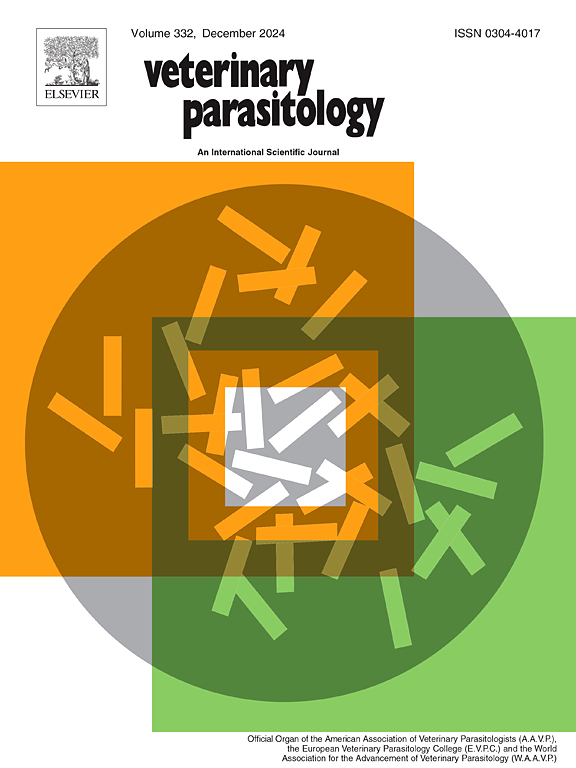Efficacy of eprinomectin 5 mg/mL topical solution administered pour on at 1 mg per kg body weight against Przhevalskiana silenus myiasis in goats
IF 2
2区 农林科学
Q2 PARASITOLOGY
引用次数: 0
Abstract
The larvae of the goat warble fly, Przhevalskiana silenus, chiefly parasitize domestic goats. Its occurrence in Europe is restricted to the southeastern Mediterranean and the southern Balkans; however, the parasite is prevalent and of considerable economic impact in the Middle East and in parts of Asia. Eprinomectin 5 mg/mL topical solution (EPRINEX® Multi, Boehringer Ingelheim) administered at 1 mg eprinomectin per kg body weight pour on was recently authorized as an anthelmintic for sheep and goats with zero hours milk withdrawal in several European countries. Considering that the product in cattle has claims against a broad range of parasites including infestation with warble fly larvae (Hypoderma spp.), this study aimed to test the efficacy of eprinomectin 5 mg/mL topical solution against P. silenus myiasis in goats. Forty-five goats sourced from a farm with a history of P. silenus infestation were randomly assigned to three groups of 15 animals each. Group 1 was untreated (control) while Groups 2 and 3 were treated once with eprinomectin 5 mg/mL topical solution at 1 mL per 5 kg body weight, either in the absence of clinical evidence of P. silenus larvae (Day 0, Group 2) or after warbles had formed (Day 167, Group 3). Goats were examined for warbles on Days 89, 103, 117, 131, 163, 174 and 181, and larvae were collected, examined for viability and speciated. On Day 186, the goats were euthanized, skinned, and examined for remaining larvae. No live larvae were recovered from goats included in treated groups while live larvae were collected from six of the 15 untreated animals (1–3 per animal) (P < 0.01 at α=0.05) demonstrating complete efficacy of the treatments. All larvae collected were identified as P. silenus. The administration of the treatments was well accepted by all animals and no related adverse events were observed. Eprinomectin 5 mg/mL topical solution was demonstrated to be an efficacious and safe treatment against P. silenus myiasis both when the larvae of P. silenus were expected to be L1/L2 and before skin damage occur, and when warbles with L3 have already developed.
依普诺菌素5 mg/mL外用溶液按1 mg / kg体重滴注对山羊白僵虫病的防治效果
山羊鸣蝇的幼虫,主要寄生在山羊身上。它在欧洲的分布仅限于地中海东南部和巴尔干半岛南部;然而,这种寄生虫在中东和亚洲部分地区很普遍,并造成相当大的经济影响。Eprinomectin 5 mg/mL外用溶液(EPRINEX®Multi,勃林格殷格翰公司),以每公斤体重1 mg Eprinomectin的剂量灌注,最近在几个欧洲国家被批准作为绵羊和山羊的零小时停奶的驱虫药。考虑到该产品在牛中具有抗多种寄生虫的功效,包括抗莺蝇幼虫(Hypoderma spp.)的侵害,本研究旨在测试依普诺菌素5 mg/mL外用溶液对山羊P. silenus蝇蛆病的功效。45只山羊来自一个有沉默单孢杆菌感染史的农场,随机分为三组,每组15只。在没有临床证据的情况下(第0天,第2组)或在莺鸣形成后(第167天,第3组),分别给予依普诺菌素5 mg/mL外用溶液1次(每5 kg体重1 mL)。在第89、103、117、131、163、174和181天对山羊进行莺鸣检查,收集幼虫,检查其活力并进行物种鉴定。在第186天,山羊被安乐死,剥皮,并检查剩余的幼虫。处理组山羊未采到活幼虫,而15只未处理的山羊中有6只(每只1-3只)采到活幼虫(P <; 0.01,α=0.05),表明处理完全有效。收集到的所有幼虫均鉴定为沉默假单胞虫。所有动物都很好地接受了治疗,没有观察到相关的不良事件。epprinomectin 5 mg/mL外用溶液在拟为L1/L2和皮肤损伤前,以及L3型莺已经发育时,均能有效、安全地治疗白腹假蝇蛆病。
本文章由计算机程序翻译,如有差异,请以英文原文为准。
求助全文
约1分钟内获得全文
求助全文
来源期刊

Veterinary parasitology
农林科学-寄生虫学
CiteScore
5.30
自引率
7.70%
发文量
126
审稿时长
36 days
期刊介绍:
The journal Veterinary Parasitology has an open access mirror journal,Veterinary Parasitology: X, sharing the same aims and scope, editorial team, submission system and rigorous peer review.
This journal is concerned with those aspects of helminthology, protozoology and entomology which are of interest to animal health investigators, veterinary practitioners and others with a special interest in parasitology. Papers of the highest quality dealing with all aspects of disease prevention, pathology, treatment, epidemiology, and control of parasites in all domesticated animals, fall within the scope of the journal. Papers of geographically limited (local) interest which are not of interest to an international audience will not be accepted. Authors who submit papers based on local data will need to indicate why their paper is relevant to a broader readership.
Parasitological studies on laboratory animals fall within the scope of the journal only if they provide a reasonably close model of a disease of domestic animals. Additionally the journal will consider papers relating to wildlife species where they may act as disease reservoirs to domestic animals, or as a zoonotic reservoir. Case studies considered to be unique or of specific interest to the journal, will also be considered on occasions at the Editors'' discretion. Papers dealing exclusively with the taxonomy of parasites do not fall within the scope of the journal.
 求助内容:
求助内容: 应助结果提醒方式:
应助结果提醒方式:


